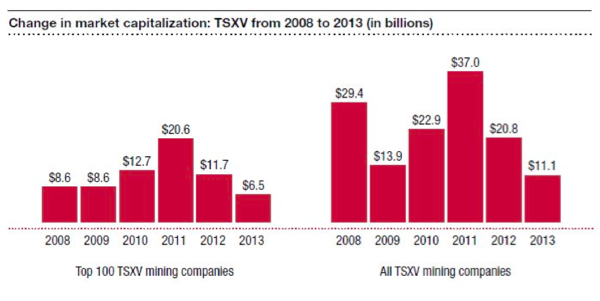As a general rule, the most successful man in life is the man who has the best information
PricewaterhouseCooper’s annual look at the state of the top 100 on the Toronto Stock Exchange Venture (TSX.V) paints a dismal picture:
 Below is the year to date statistics from the TSX Venture exchange.
Below is the year to date statistics from the TSX Venture exchange.
“The price-driven, seemingly indiscriminate support that speculative juniors received from retail equity investors prior to the financial crisis is not on hand today.” E&Y’s Global Mining and Metals Center in the report, Business risks facing mining and metals 2013-2014
Consider:
“Contracting risk appetites have weighed heavily on junior miners’ access to funding. A high risk-reward ratio is the industry’s “sweet spot,” notes PwC. But it is apparent that market participants currently prefer less volatility, more security and higher rewards.” Michelle Smith, Resource Investing News
It’s a fact in the mining world that most discoveries are made by junior exploration companies – juniors are the most adept at finding our future mines. They already own, and find more of, what the world’s larger mining companies need to replace reserves and grow their asset base.
Let’s define what we’re looking for; a quality management team; cash in the treasury; ability to raise more if needed; pretty much a ‘no-brainer going mining’ situation, the holy grail of success for juniors – upcoming cash flow.
All of this has to be not only in a politically stable country but one that is also free from resource nationalism and native activism.
Who might a couple of these juniors be?
Hudson Resources Inc. HUD:TSX.V. Hudson has the White Mountain anorthosite project in the southwest coastal region of Greenland. Anorthosite is calcium feldspar, which is basically sand containing aluminum, calcium, low levels of soda and 1% iron. It could serve as an alternative material in many industrial applications:
The company is close to the point where it can load its anorthosite onto a deep-sea cargo ship and transport it anywhere in the world, year-round.
Uranerz Energy Corp., TSX and NYSE MKT – URZ (Frankfurt Stock Exchange – U9E). The company currently controls a large strategic land position in the Pumpkin Buttes Uranium Mining District of the central Powder River Basin of Wyoming and has almost completed construction of its first in-situ recovery (ISR) uranium mine.
URZ is approximately one month from mine completion and starting a three month inventory stockpiling program. After shipment of its first inventory it will be 30 days before Uranerz receives payment – let’s call for the cash flow to start in the second quarter of 2014. URZ recently announced receipt of a $20,000,000.00 Wyoming State Industrial Bond.
VMS Ventures Ltd. VMS:TSX.V, is the discoverer of Reed Copper deposit – likely the next copper mine to enter production in Canada. In 2010 the VMS Ventures team signed a Joint Venture Agreement with Hudbay Minerals Inc. for the Reed Copper project. The JV agreement established that Hudbay would hold a 70 per cent and VMS a 30 per cent interest in the property and act as the operator.
VMS Ventures’ portion of the mine construction costs is to be financed by Hudbay and is to be paid back out of the proceeds from production. Full production remains on schedule to commence by the second quarter of 2014.
Global Cobalt Corp. GCO:TSX.V, is focused on developing it’s Karakul Cobalt Project in the Republic of Altai, Russia. Currently there is a $3 million drill program utilizing 3 drill rigs underway as well as a feasibility study which will include latest results as well as historical Soviet results.
The company has signed an off-take agreement for up to 100% of the property’s production with Beijing Easpring Material Technology, who counts Beijing General Research Institute of Mining & Metallurgy among its major shareholders.
Conclusion
If junior exploration companies aren’t exploring and making discoveries because of a lack of funding then those juniors already with discoveries, the ones that are well along the development path to being a mine, are definitely considered to be in an investor’s sweet spot.
They are also worth that much more – because of the upcoming reserve replacement squeeze – to a major mining company and investors looking for a potential takeover candidate. Beginning cash flow also enables management to grow the company by taking advantage of the poor situations so many others find themselves in.
A lack of exploration means a lack of discoveries, add in the fact it takes 11 years to get into production and we can see the enormous mineral supply deficit gaping wider, and for far longer than in a normal mining cycle downturn.
Juniors with quality deposits heading to cash flow should be on every investors radar screen. I’ve given you four, are they on your radar screen?
If not, they should be.